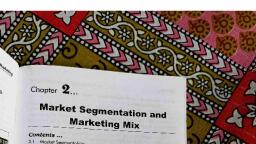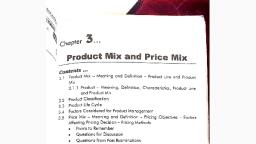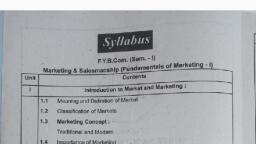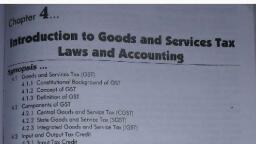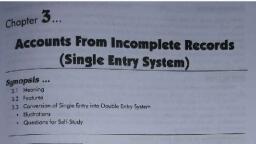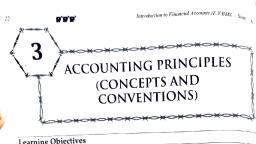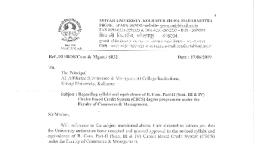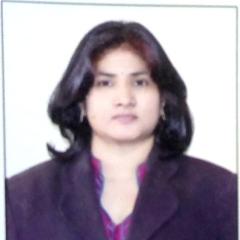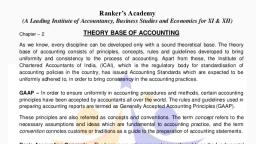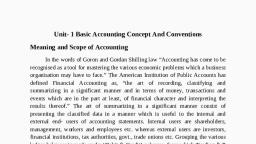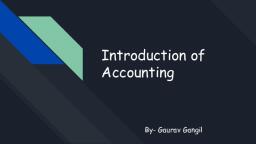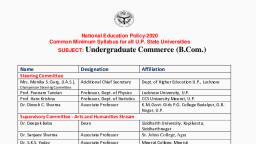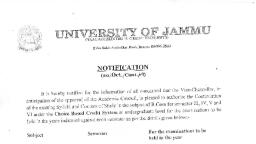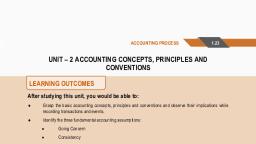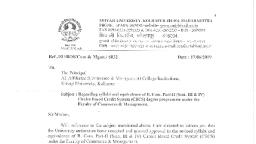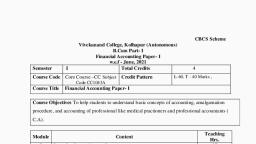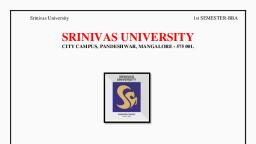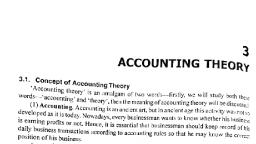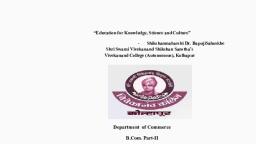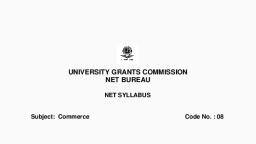Page 1 :
Syllabus.., FINANCIAL ACCOUNTING (Semester 1), Course Code - 112, Number of Credits : 03 and for Practical - 01, Objectives of the Course:, 1. To impart knowledge of Basic Accounting Concepts., 2. To create awareness about Application of these Concepts in Business World., 3. To impart skills regarding Computerised Accounting., 4. To impart knowledge regarding Finalisation of Accounts of various establishments., Unit, Unit Title, Purposed Skills to be, developed, Contents, No., 1. Accounting Concepts,, Conventions and Principles, (A) Accounting Concepts,, Conventions and Principles, Knowledge about various, accounting, concepts,, and an Overview of Emerging, 1. Money Measurement, conventions and principles., Trends in Accounting, 2. Business Entity, Understanding emerging, 3. Dual Aspect, trends in accounting and its, effect, on, accounting, 4. Periodicity Concept, practices., 5. Realisation Concept, 6. Matching Concept, 7. Accrual/Cash Concept, 8. Consistency Concept, 9. Conservatism Principle, 10. Materiality Concept, 11. Going Concern Concept, 12. Historical Cost Concept, (B) Emerging Trends in Accounting, 1. Inflation Accounting, 2. Creative Accounting, 3. Environmental Accounting, 4. Human Resource, Accounting, 5. Forensic Accounting
Page 2 :
2., Piecemeal Distribution of Cash, Knowledge about proCess of, Dissolution of partnershio, 1. Surplus Capital Method only,, Asset taken over by a partner,, 2. Treatment of past profits or past, Firm,, losses in the Balance Sheet,, 3. Contingent liabilities, 4. Realisation, expenses/amount, kept aside for expenses, 5. Adjustment of Actual, Treatment, of Secured Liabilities,, 6. Treatment of Preferential, Liabilities like Government, dues/Labour dues etc.,, Excluding: Insolvency of Partner, and Maximum Loss Method., 3., Accounts from Incomplete, 1. Meaning of Single Entry System, Knowledge about Single, Entry Systems., Records (Single Entry System) 2. Features of Single Entry System, Purpose and Advantages of, Double Entry System., 3. Conversion of Single Entry into, Double Entry, • Process of Conversion of, Single Entry into Double, Entry System., 4., Introduction to Goods and, 1. Constitutional Background of, Knowledge about, Services Tax Laws and, GST, Concepts and Definition of, Conceptual Framework of, Accounting, GST., the GST., 2. IGST, CGST and SGST, Knowledge about various, 3. Input and Output Tax Credit, components of GST., 4. Procedure for Registration under, Types of Taxes under GST., GST, Registration process under, GST, for, Business, Establishments.
Page 3 :
Contents .., 1. Accounting Concepts, Conventions and, Principles and Emerging Trends in Accounting, 1.1 - 1,46, 2. Piecemeal Distribution of Cash, 2.1 - 2.38, 3. Accounts from Incomplete Records, (Single Entry System), 3.1 - 3.46, 4. Introduction to Goods and Services Tax, Laws and Accounting, 4.1 - 4.28, Appendices :, Objective Questions, T.1 - T.3, i) True or False Statements, Ii) Fill in the Blanks, F.1 - F.3, Bibliography, B.1 - B.1, ***
Page 4 :
LIST OF FIGURES, GRAPHS AND CHARTS, 1.1 Accounting Concepts and Conventions, 1.18, 1.2 Inflation Adjusted Financial Statements, 1.20, 1.3 Techniques of Inflation Accounting, 1.4 The Relationship between the Economy and the, 1.27, Environment, 1.28, 1.5 Organisation of Environment Accounting, 1.35, 1.6 Cost of Human Resources, 1.37, 1.7 Methods of Valuation of Human Resources, 2.2, 2.1 Classification of Liabilities, 2.2, 2.2 Sub-classification of Liabilities, 2.3 Methods of Distribution of Cash, among, the, partners, 2.6, 3.2, 3.1 Classification of Single Entry System, 3.2 Methods for Ascertainment of Profit or Loss or, Sole Trader, 3.5, 4.1 Pattern of Tax Levy, 4.2, 4.2 Constitutional History of Goods and Service Tax, (GST) Law, 4.6, 3 Basic GST Process, 4.16, ***
Page 5 :
Chapter 1..., Accounting Concepts, Conventions and, Principles and Emerging Trends in, Accounting, Synopsis ..., 1.1 (A) Accounting Concepts, Conventions and Principles, 1.1.1 Accounting Principles, 1.1.2 Accounting Concepts and Convenfions, 1.1.2.1 Money Measurement, 1.1.2.2 Business Entity, 1.1.2.3 Dual Aspect, 1.1.2.4 Periodicity, 1.1.2.5 Realisation, 1.1.2.6 Matching, 1.1.2.7 Accrual/ Cash, 1.1.2.8 Consistency, 1.1.2.9 Conservatism, 1.1.2.10 Materiality, 1.1.2.11 Going Concern, 1.1.2.12 Historical Cost, 1.2 (B) Emerging Trends in Accounting, 1.2.1 Inflation Accounting, 1.2.2 Creative Accounting, 1.2.3 Environmental Accounting, 1.2.4 Human Resource Accounting, 1.2.5 Forensic Accounting, • Questions for Self-Study, 1.1 (A) ACCOUNTING CONCEPTS, CONVENTIONS AND PRINCIPLES, Usually, the primary and secondary books of accounts maintained by the businessman more, accurately, are summarised at the end of a financial period and disclosed in the form of financial, statements more scientifically and systematically too. These accounts and the statements are, ultimately communicated to all concerned parties for the update knowledge and adequate, information of the public at large. These documents, statements and reports convey the exact, financial information about their performances in logical manuner, which forms the basis of, decisions to be taken by the internal and external parties. The accounting data so created is, (1.1)
